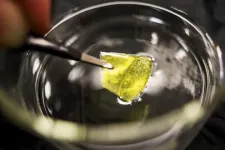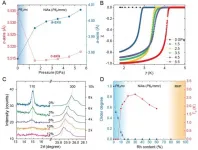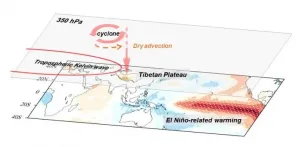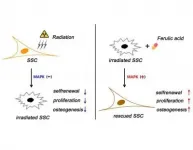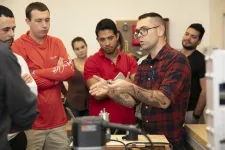(Press-News.org) One prospective source of renewable energy is hydrogen gas produced from water with the aid of sunlight. Researchers at Linköping University, Sweden, have developed a material, nanoporous cubic silicon carbide, that exhibits promising properties to capture solar energy and split water for hydrogen gas production. The study has been published in the journal ACS Nano.
"New sustainable energy systems are needed to meet global energy and environmental challenges, such as increasing carbon dioxide emissions and climate change", says Jianwu Sun, senior lecturer in the Department of Physics, Chemistry and Biology at Linköping University, who has led the new study.
Hydrogen has an energy density three times that of petrol. It can be used to generate electricity using a fuel cell, and hydrogen-fuelled cars are already commercially available. When hydrogen gas is used to produce energy, the only product formed is pure water. In contrast, however, carbon dioxide is created when the hydrogen is produced, since the most commonly used technology used today depends on fossil fuels for the process. Thus, 9-12 tonnes of carbon dioxide are emitted when 1 tonne of hydrogen gas is produced.
Producing hydrogen gas by splitting water molecules with the aid of solar energy is a sustainable approach that could give hydrogen gas using renewable sources without leading to carbon dioxide emissions. A major advantage of this method is the possibility to convert solar energy to fuel that can be stored.
"Conventional solar cells produce energy during the daytime, and the energy must either be used immediately, or stored in, for example, batteries. Hydrogen is a promising source of energy that can be stored and transported in the same way as traditional fuels such as petrol and diesel", says Jianwu Sun.
It is not, however, an easy task to split water using the energy in sunlight to give hydrogen gas. For this to succeed, it is necessary to find cost-efficient materials that have the right properties for the reaction in which water (H2O) is split into hydrogen (H2) and oxygen (O2) through photo-electrolysis. The energy in sunlight that can be used to split water is mostly in the form of ultraviolet radiation and visible light. Therefore, a material is required that can efficiently absorb such radiation to create charges that can be separated and have enough energy to split the water molecules into hydrogen and oxygen gases. Most materials that have been investigated until now are either inefficient in the way they use the energy of visible sunlight (titanium dioxide, TiO2, for example, absorbs only ultraviolet sunlight), or do not have the properties needed to split water to hydrogen gas (for instance, silicon, Si).
Jianwu Sun's research group has investigated cubic silicon carbide, 3C-SiC. The scientists have produced a form of cubic silicon carbide that has many extremely small pores. The material, which they call nanoporous 3C-SiC, has promising properties that suggest it can be used to produce hydrogen gas from water using sunlight. The present study has been published in the journal ACS Nano, and in it the researchers show that this new porous material can efficiently trap and harvest ultraviolet and most of the visible sunlight. Furthermore, the porous structure promotes the separation of charges that have the required energy, while the small pores give a larger active surface area. This enhances charge transfer and increases the number of reaction sites, thus further boosting the water splitting efficiency.
"The main result we have shown is that nanoporous cubic silicon carbide has a higher charge-separation efficiency, which makes the splitting of water to hydrogen much better than when using planar silicon carbide", says Jianwu Sun.
INFORMATION:
The research has received financial support from, among other sources, the Swedish Research Council, FORMAS, and The Swedish Foundation for International Cooperation in Research and Higher Education.
The article: "Nanoporous Cubic Silicon Carbide Photoanodes for Enhanced Solar Water Splitting", Jing-Xin Jian, Valdas Jokubavicius, Mikael Syväjärvi, Rositsa Yakimova and Jianwu Sun, (2021), ACS Nano, published online 19 February 2021, doi: 10.1021/acsnano.1c00256
https://doi.org/10.1021/acsnano.1c00256
A lot of the attention around "pandemic pets" has focused on families with children getting a cat, dog or other pet in 2020, during a time when many people were learning or working from home.
But a new poll shows that older adults also got in on the trend.
According to the National Poll on Healthy Aging, 10% of all people between the ages of 50 and 80 got a new pet between March 2020 and January 2021.
The percentage was indeed higher - 16% -- among the people in this age range who have at least one child or teen living with them. But the vast majority of people between the ages of 50 and 80 don't live with someone under age 18 -- and nearly 9% of them also got a pet during the pandemic.
All told, 59% of people age 50 to 80 who completed the poll in January 2021 are pet owners. ...
The Covid-19 pandemic severely impacted the mental health of young people, with increased levels of clinical depression being identified, a new study published in the journal Psychiatry Research reports. A decrease in alcohol consumption was also identified amongst young people during the pandemic.
During this unique study researchers from the University of Surrey surveyed 259 young people pre- pandemic (autumn 2019) and in the midst of initial lockdown measures (May/June 2020) on their levels of depression, anxiety, wellbeing, alcohol use and sleep quality.
Researchers found evidence of a substantial impact on the mental health of these young adults due ...
Research has found that experiencing a traumatic event at close quarters changes people's political attitudes. However, in the case of the 2017 terrorist attack in Stockholm, proximity to the attack had no additional political significance. Research from the University of Gothenburg shows that Swedes' attitudes toward terrorism-related questions were affected equally, regardless of whether they happened to be close to the attack.
On 7 April 2017, Rakhmat Akilov stole a truck and ran down multiple people on Drottninggatan, a street in central Stockholm. Five people died, fifteen were injured and many people witnessed ...
A study which looked at activity levels before and during the COVID-19 pandemic has found lockdown restrictions significantly reduced light activity associated with socialising and work.
The study, published recently in BMJ Neurology and led by King's College London, examined how activity levels changed in study participants with muscular dystrophy and other inheritable myopathies. The sample included people with a range of physical abilities, from highly independent to assisted mobility, including 41 wheelchair users, who are often underrepresented in research. However, the authors say the findings are likely to be relevant to adults of various ...
The excavation of shell middens off two sites in the Gulf of Mexico and Northern Europe dating back to when the seabed was dry land thousands of years ago, reveal how they can offer new ground-breaking insights into the hidden history of submerged landscapes.
An international team of archaeologists from Moesgaard Museum (Denmark), the University Of Georgia (USA), the University of York (UK) Flinders University and James Cook University partnered to excavate two sites containing shell middens in the Gulf of Mexico and Eastern Jutland in Denmark in 2018, showing that middens can be ...
Crystals inherently possess imperfections. Vacancies, as the simplest form of point defects, significantly alter the optical, thermal, and electrical properties of materials. Well-known examples include colour centres in many gemstones, the nitrogen-vacancy centre in diamond, vacancy migration in solid-state batteries, and the metal-insulator transition in phase-change materials. The vacancies in these cases are in frame-works with no or weak interactions. However, the role of vacancies in strongly correlated materials is thus far unclear due to the lack of an ideal prototype.
Strongly ...
El Nino-Southern Oscillation (ENSO) is a recurring climate phenomenon involving changes in the temperature of waters in the central and eastern tropical Pacific Ocean. It is one of the most important climate perturbations on Earth because it can change the global atmospheric circulation, which in turn, influences temperature and precipitation across the globe. Scientists have found ENSO has an impact on hydroclimate over the Tibetan Plateau but how it works, or its physical mechanism, remains unclear.
In a recently published research article in Journal of Climate, Shuai Hu, Tianjun Zhou and Bo Wu from the Institute of Atmospheric Physics, Chinese Academy of Sciences, explored the dynamical processes that ...
Durham, NC - The standard of treatment for bone tumors is often two-fold: surgery to remove the cancerous section followed by radiation therapy to ensure all the cancerous cells have been killed off. This is an effective way to defeat bone tumors; however, it often results in large bone defects and hampers wound healing because of extensive tissue cutoff and irradiation-induced tissue damage. A new study published in STEM CELLS Translational Medicine demonstrates how stem cells primed with ferulic acid can repair such bone damage and how this occurs. The information this study provides could aid in the development of new treatments for irradiated bone injuries.
Heng Zhu, M.D., Ph.D., of the Beijing Institute of ...
As World Water Day is observed around the globe, new research from UBC Okanagan suggests a systematic approach to forest and water supply research may yield an improved assessment and understanding of connections between the two.
Healthy forests play a vital role in providing a clean, stable water supply, says eco-hydrologist Dr. Adam Wei.
Acting as natural reservoirs, forests in watersheds release and purify water by slowing erosion and delaying its release into streams. But forests are changing--in part because of human activity--and that's having an impact on forests' interaction with hydrological ...
Latino undergraduate male college students are involved in many leadership roles, yet how this leadership evolves in higher education has been understudied. Researchers from Florida Atlantic University in collaboration with San Diego State University and Texas A&M University explored how Latino male college students make meaning of their masculinity and how this meaning shapes their understanding and performance of leadership.
The study published in the International Journal of Leadership Education, utilized a qualitative method to delve deep into the understandings of the masculinities, gender socialization, leadership and transfer experiences of 34 Latino undergraduate male students. Using a philosophical approach, the researchers ...
